There’s a big hype going on about chatbots. If you’ve heard of them but aren’t quite sure what exactly they are or how they work, you’re in the right place.
This article will explain what chatbots are and how they can help you take your digital marketing to the next level. I’m not using “to the next level” as an idiom, because chatbot marketing might just be the next big thing. Incorporating chatbots in marketing can streamline customer interactions and significantly enhance your marketing strategy. It has the potential to revolutionize the marketing world!

Chatbots can improve and benefit your marketing and sales in many ways. They apply to support requests, e-commerce and even personal or informational websites. You can find some of the best techniques in this article.
In a nutshell, Chatbot Marketing is about promoting products and services using chatbots.
Stick with me and below I’ll show you exactly how you can set up your own chatbot, and how you can put it to good work plus many more.
- What Is a Chatbot and How Does It Work ?
- Why Chatbots Are the Future of Digital Marketing
- Best Uses of Chatbots
- Can ChatBot Marketing Improve SEO?
1. What Is a Chatbot and How Does It Work ?
Chatbots are complex computer software designed to chat with persons and perform different actions, from simple conversation to customer support and e-commerce.
They are becoming increasingly crucial in social media and marketing efforts, helping businesses grow your business and boosting sales.
A chatbot is short for “chat robot”. We think of robots as machines, but ‘robot’ actually means ‘forced labor’.
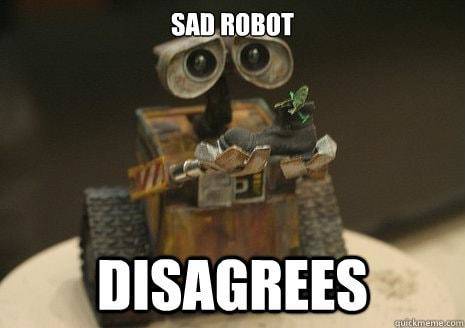
Source: quickmeme.com
Marketing chatbots go beyond just basic interactions—they can play a pivotal role in lead generation, improving customer experiences, and streamlining customer care. By integrating a marketing chatbot into your social media strategy, businesses can enhance their interaction with customers, answer marketing messaging, and provide live chat services.
Chatbots are not only about imitating real conversations. Modern AI chatbots, powered by artificial intelligence (AI) and machine learning, can learn from customer experiences to deliver more personalized service, which is particularly useful for holiday season promotions or loyalty programs.
These bots can be set up on various platforms, including a WordPress chatbot, allowing marketers to promote products, offer welcome messages, and manage marketing campaigns.
Businesses that set up marketing chatbots can see the benefits of chatbot marketing almost immediately. Whether it’s on landing pages, within shopping experiences, or even as part of a partner program, these chatbots help promote products and improve conversion rates. Moreover, chatbots can be a valuable marketing channel, helping businesses increase engagement on social media and content marketing efforts.
While chatbots aren’t yet perfect—they haven’t truly passed the Turing Test—chatbots for marketers are evolving rapidly. They now play a significant role in digital marketing, allowing businesses to efficiently manage customer interactions and collect customer data. For instance, chatbots can assist customers and seamlessly transfer them to a human agent when necessary, ensuring that the shopping experience is both efficient and enjoyable.
In conclusion, while there is still room for improvement, integrating chatbots into your marketing strategy can enhance customer experiences, increase social media engagement, and ultimately, help your business thrive.
Or, how Hamza puts it…
Here we go…someone had to do this meme in the end…#bots #AI #chatbots pic.twitter.com/w9EBQ7awtT
— Hamza Harkous (@hamzaharkous)
In the next section, you’ll discover why chatbots are becoming more popular and why companies started investing in them.
2. Why Chatbots Are the Future of Digital Marketing
In case you that chatbots are a big trend now, here is a Google Trend from 2017; the interest started long time ago.
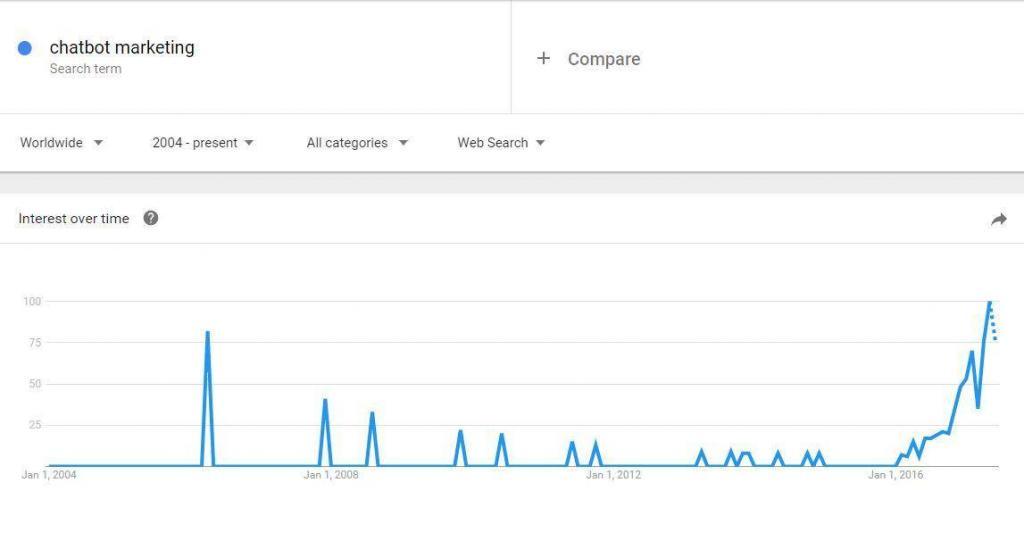
The term had a big but very short trend somewhere between 2006 and 2007. This happened when the first chatbots appeared on the web. Although cool at first, since they were not helpful in any way, people lost interest fast.
However, chatbots are becoming more sophisticated today and come in various forms, serving a wide range of purposes. Modern AI-powered chatbots and virtual assistants are designed to provide more value, such as offering personalized recommendations and quick replies to common questions. These bots are improving customer interaction and customer satisfaction by keeping conversations flowing and guiding users to relevant solutions.
In 2015, Baidu, China’s biggest search engine, introduced an AI-powered chatbot called Melody, a medical assistant designed to help solve the healthcare crisis.
Melody can chat with people at home to assist in diagnosing possible illnesses, showing how aipowered chatbots can make a real difference by improving customer experience in critical sectors.
Today’s chatbots serve a wide variety of purposes, from messenger bots that engage website visitors and potential clients, to tools that enhance brand awareness by delivering news and updates directly to users.
Marketers can now build your own chatbot to fit specific needs, like segmenting traffic or providing personalized recommendations based on user preferences.
These chatbots guide users through processes and offer quick responses to FAQs, improving customer satisfaction and making customer interaction more efficient.
By integrating chatbots into their strategies, businesses can better manage customer interaction while providing personalized recommendations and guiding potential clients through their products or services. Whether you’re using a chatbot to segment traffic or to deliver news and updates, chatbots are a powerful tool for improving customer experiences and increasing engagement.
Abhimanyu Godara, founder of Bottr.me said that chatbots will fix the app clutter, as many apps can be replaced. He also said that soon, everyone will have their own chatbot.
| Marketing is shifting from logos to faces, from brands to people. The chatbot talks to you, and the process becomes a lot more interactive, creating engagement. | |
 |
Abhimanyu Godara |
| CEO at Bottr.me / @abh1manyu | |
Abhimanyu is definitely right:
You can see the personal brand business model become more and more popular (especially in the digital marketing industry). People like Gary Vaynerchuk, Neil Patel and Brian Dean and many others promote and use this model. Even Richard Branson is using his personal brand to promote his businesses.
Big brands will still be in the game, though. But every business will also have its own chatbot.
Here’s why:
Messaging apps are growing really fast. Faster than social media itself!
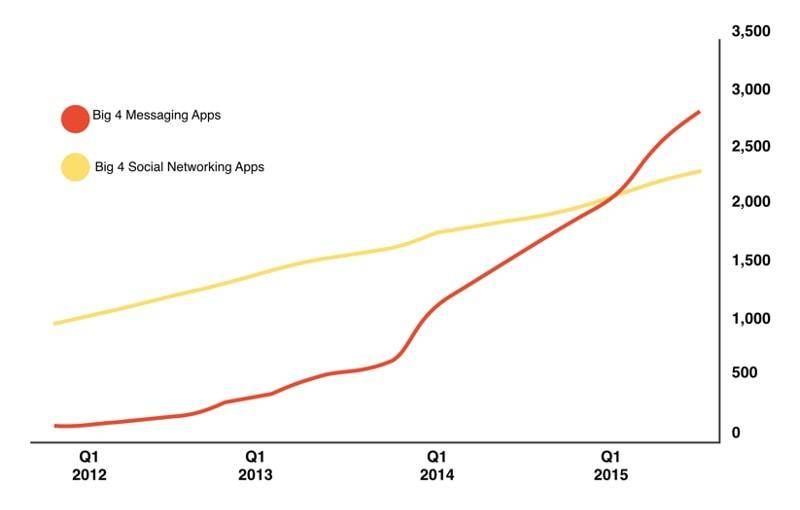
Business Insider
If they become the #1 way people talk to each other, businesses will have to find a way to engage with their customers there.
Mobile search is growing, and Google is testing the mobile first indexing. This tells us that people will use the messenger apps even more. Chatbots apply best to people using mobile devices.
One way would be setting up customer support departments. That is not cost effective, and many businesses won’t do it.
The other way, is having chatbots.
Chatbots can make small businesses much more competitive, especially in digital marketing. With the help of artificial intelligence and well-designed chatbot platforms, small teams can manage a significantly higher volume of clients and qualify leads more efficiently.
Even though it might sound crazy, chatbots may eventually challenge traditional apps and websites. An app requires space and needs to be downloaded, while websites take time to load, and many are quite slow. However, messenger chatbots and WhatsApp chatbots work instantly. You type something, and they respond immediately. This is where conversational AIs and AI agents excel, as they bypass the traditional user interface, completely changing how customers engage with your business. People can navigate content using their natural language, creating a seamless customer journey.
By integrating chat plugins with messaging apps like Facebook Messenger or WhatsApp, businesses can improve customer interactions and provide faster, more efficient service. Chatbots can also help in real estate, contact sales teams, and even gather valuable customer feedback.
For businesses looking to implement chatbots, chatbot builders are available to help you create a tailored chatbot marketing strategy. Some great chatbot marketing examples include using messenger chatbots to handle customer feedback, answer FAQs, and offer personalized recommendations.
Chatbots are not just a tool for large businesses; they can be a game-changer for small businesses looking to streamline customer service, enhance the customer journey, and qualify leads without adding more staff. By incorporating chatbots into their digital marketing strategies, businesses can provide a better user experience, improve efficiency, and stay competitive in today’s fast-paced world.
But don’t get too hyped yet! Chatbots are still far from becoming a standard.
Ilan Kasan, CEO at Exceed.ai said in January 2017 that the chatbot technology is going through the Gartner’ Hype Cycle. Back then, it was standing on the Peak of Inflated Expectations. Right now, it started to fall in the Trough of Disillusionment.
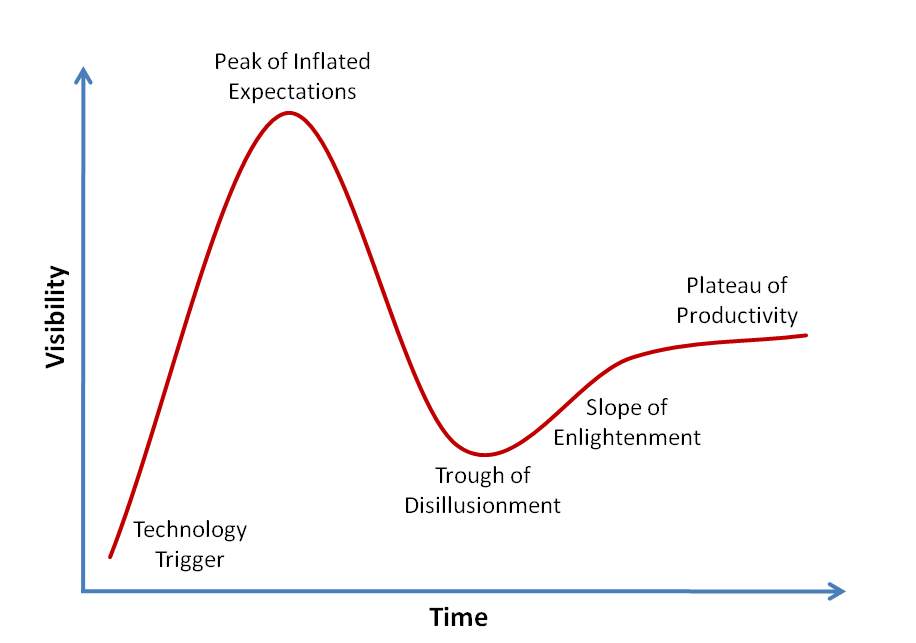
The Gartner Hype Cycle is a timeline of how new technologies appear on the market. This applies to most things in the IT field.
As Ilan said it…
| Get ready for the Trough of Disillusion … it’s coming soon. With it, many chatbot companies will vanish. Eventually, as the technology improves and the market understand the best use cases for chatbots, winners will emerge. | |
 |
Ilan Kasan |
| CEO @ilankasan / exceed.ai | |
My research kind of proves Ilan’s theory.
I’ve contacted some people who use chatbots directly on their website. So far, their results were either mixed or missing altogether.
| The experience is still confusing so even if people are trying it, it’s telling from their messages that they aren’t sure what the chatbot does or how it works. | |
 |
Paul O’Brien |
| Blogger at seobrien.com / @seobrien | |
Here’s another response:
I couldn’t get any real value so I stopped using it.
— Harsh Agrawal (@denharsh) June 14
Now that was… Harsh.
On the other hand, on platforms like Facebook Messenger, the read rates can get extremely high. Matthew Barby, Head of SEO at Hubspot tells us about his experience:
| It’s still early days and I have a lot more experiments ongoing within Messenger in particular, but I’ve seen read rates of my push messages of over 90% – which is insane! | |
 |
Matthew Barby |
| Blogger at matthewbarby.com / @matthewbarby | |
Still, even with all the current problems, setting up a bot can kickstart your site’s growth.
Sujan Patel, a renowned expert in growth hacking and co-founder of Voila Norbert, has been talking about chatbot marketing as a growth technique for a while..
| Chatbots can definitely be a growth tactic as it could help increase leads, start conversions/engage with potential customers and get feedback. | |
 |
SUJAN PATEL |
| Blogger at sujanpatel.com / @sujanpatel | |
Although people are barely scratching the surface of chatbots potential, it’s still a good idea to get started with them. Learning the technology now can gain you an advantage over the competition in the future. These types of software are prone to becoming popular in the days to come.
Let’s take a look at some of the best use cases for chatbot marketing.
3. Best Uses of Chatbots for Marketing
Chatbots have evolved significantly, and today they can be applied across various industries to enhance user experience and boost business outcomes. Whether you’re focused on lead generation, customer care, or improving conversion rates, chatbots are a key component of a modern digital marketing strategy. Here are some of the best ways to leverage chatbots in 2024:
3.1 Personal AI Assistant
A virtual assistant powered by artificial intelligence (AI) can help you save time by managing customer interactions when you’re unavailable. Well-designed chatbots app or AI assistants can handle common customer queries, respond quickly, and enhance the customer journey by mimicking natural language conversations.
Whether you’re in real estate or managing e-commerce, these assistants boost engagement and streamline processes. Examples like Facebook Messenger and WhatsApp chatbots enable real-time communication with potential customers.
Nathan Hague, an awesome Australian marketer, uses one on his personal website. After a few seconds and scrolls on the website, the invitation to chat with it will pop up. The bot is an essential aspect of Nathan’s social strategy.

Clicking on the “Send to messenger” button will take you to Facebook messenger, where the bot takes action.
His bot is very well built and has an awesome vibe. You can see that Nathan did his best to showcase his personality through his bot.
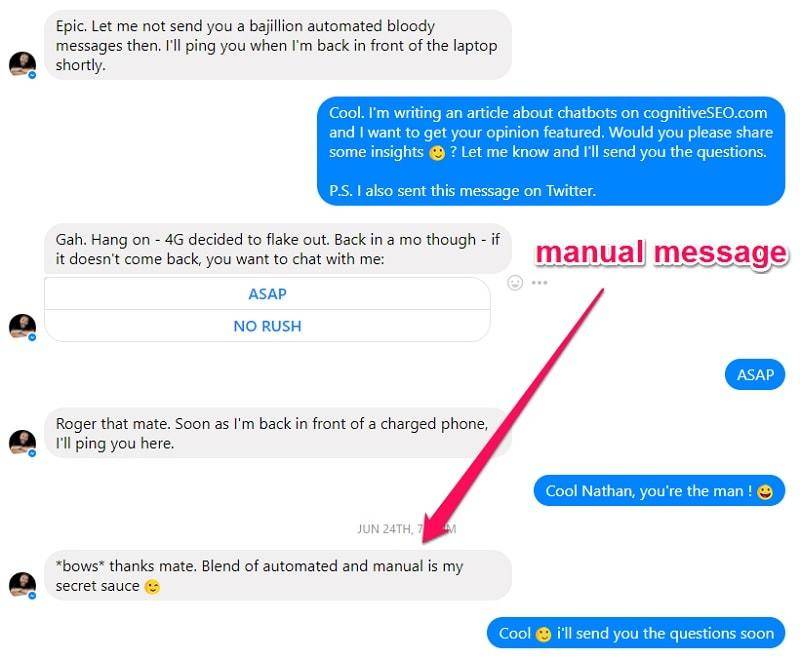
On his page, Nathan uses the bot to let people know he will respond. And he does! (Thanks, man!)
Paul O’Brien took a more complicated approach. He tries to replicate himself altogether, using a bot on his website.
| I’m seeking a virtual assistant clone of myself. Have looked into a good number of bots and have yet to find anything that works. Bottr plus Replika might come close. | |
 |
Paul O’Brien |
| Blogger at seobrien.com / @seobrien | |
On Paul’s blog, in the bottom right corner, you can notice what looks like a live chat icon. What catches your attention is Paul’s face in the icon.
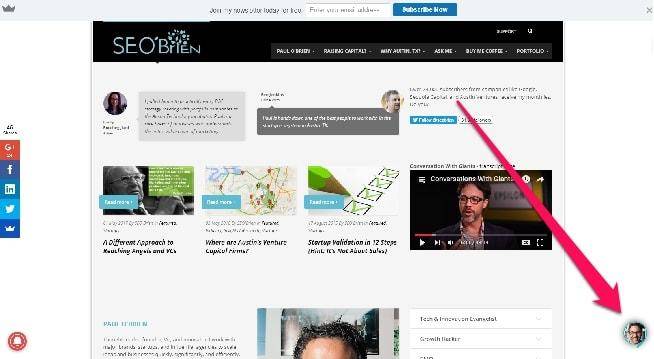
The bot still has a very long wait until it will be able to replace Paul completely. Still, you can pick from a set of questions and find more about Paul and his work. The answers are usually articles he has written on his blog or other websites. If the bot can’t answer something, it will put you in contact with Paul directly.
Having a personal virtual assistant can help you save time and get people engaged with your content.
3.2 Get Traffic to Your Site and Grow Your Audience
Using messenger bots as part of your conversational marketing strategy can drive traffic from social media to your landing pages.
Companies like WholeFoods have successfully engaged users by sending personalized recommendations based on preferences, which increases brand awareness and helps to bypass social media algorithms.
Chatbots provided to your audience in their inboxes can achieve read rates of up to 90%, which is significantly higher than traditional methods like email.
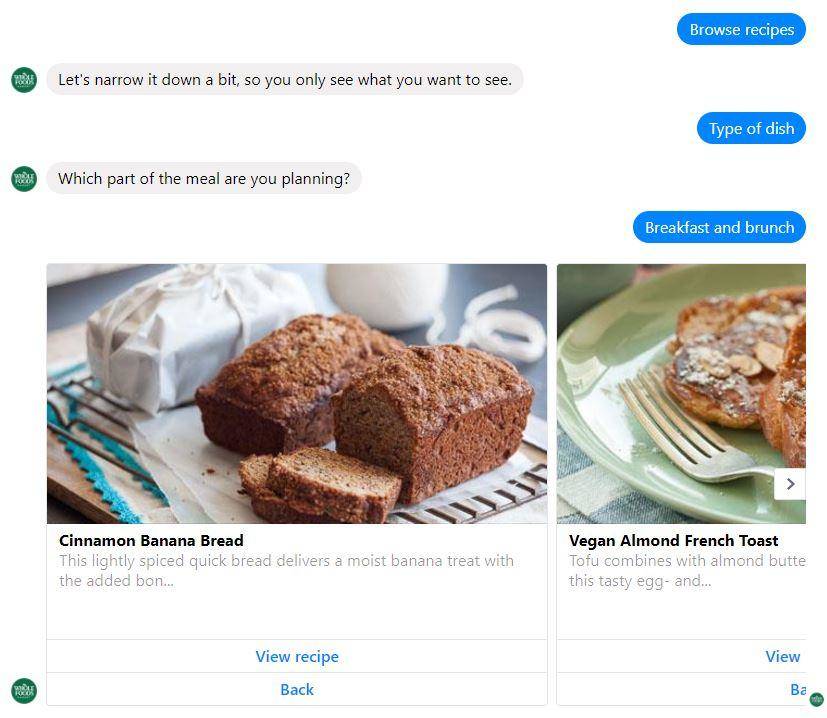
On their Facebook bot, they engage with their audience by showing them interesting recipes. Before that, they narrow the posts down by the user’s preference.
Subscribing users to your bot can help you bypass the reach algorithms and all the other clutters on social media. While others will deliver posts in the news feed, you can send them directly into the users inbox. That’s where they chat with their friends, so you know they will see your message.
Remember, by engaging with your fans directly through their inboxes, you can get read rates of up to 90% of your subscribed users.
News publishers have been using this method in their content marketing strategy for a while:

3.3 Build an E-mail List
You can integrate your chatbot with marketing automation tools to qualify leads and collect contact information. For example, chatbot platforms can help you build email lists, offer welcome messages, and even segment users based on behavior.
Nathan Hague suggests set up marketing chatbots to gather customer info and use chat plugins to engage visitors, which is especially useful during peak seasons like the holiday season.
|
My very strong suggestion though, is to use the Facebook bot more and more instead of email marketing! Remember, you’re renting your presence on Facebook and it can be taken away from you at any time! Keep building your email list in case something ever goes wrong. |
|
 |
Nathan Hague |
| Blogger at nathanhague.com / @australiawow | |
Still, he says that the upgrade from e-mail open rates of 10%-20% to Facebook messenger open rates of 90% is invaluable.
Try to use Messenger instead of E-mails, but keep building your e-mail list as a backup in case your Facebook profile/page ever gets banned.
3.4 E-commerce & Conversational Commerce
E-commerce is shifting towards conversational marketing, where chatbot builders create bots to simulate an in-store shopping experience. Brands like Kayak and H&M use chatbots to recommend products and allow users to complete purchases seamlessly.
These bots can also help with lead qualification and providing product recommendations based on user preferences, all while boosting sales. After purchases, bots can even follow up with customer feedback to enhance loyalty programs.
Many companies are doing this. Here’s an example from Kayak, the travel search engine:
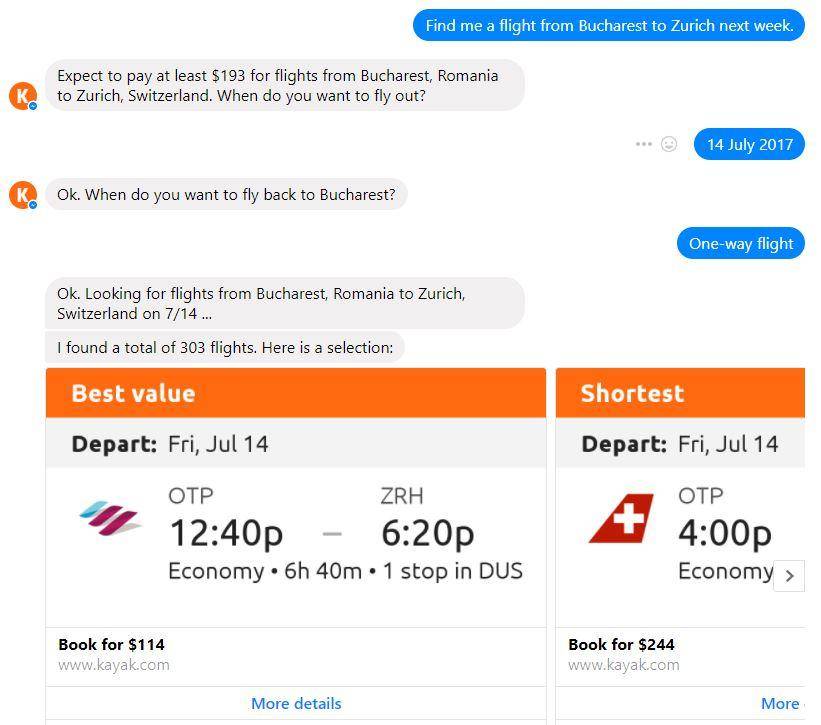
Some travel bots can even book your flight or your hotel room. Pizza Hut also uses a similar technique for their orders.
With a bot you can also classify prospects. It’s very easy to sort out consumer preferences. This also applies to all fields, from age, gender and location to interests and hobbies.
Fashion brands use this strategy to study new trends and learn about what their clients want.
Here’s an example from American Eagle:

Here’s another one from H&M, on Kik.
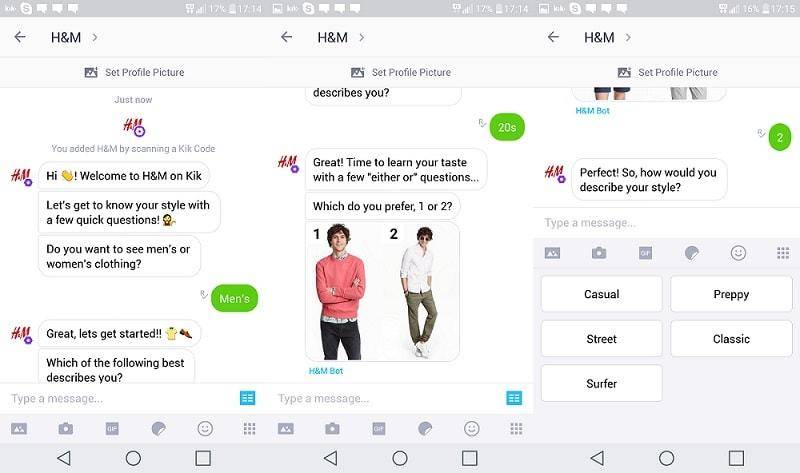
After you tell the bot your style, it sends you different outfits you might like. You can save them to favorites, skip them or select a specific product and buy it.

Unfortunately, I couldn’t purchase directly through the messaging app. Every time, the bot sent me to a website to make the final purchase. This is probably happening because I don’t live in the USA. Facebook Messenger payments are available in the USA since 2015, so we know it’s possible.
After a purchase is made, you can even set up the bot to follow-up and ask the user for feedback.
3.5 Customer Support
The most common use of AI chatbot technology is in customer care. AI agents can answer common questions instantly, reducing response time and improving customer satisfaction.
For instance, companies like 1-800-Flowers and Twitter use bots to handle initial interactions, before handing off more complex issues to a human agent.
This hybrid approach keeps conversations flowing and minimizes waiting times, while freeing up resources for the sales teams. Whether it’s through WordPress chatbots, messenger chatbot, or chatbots for marketers, integrating support bots can improve efficiency and increase user experience.
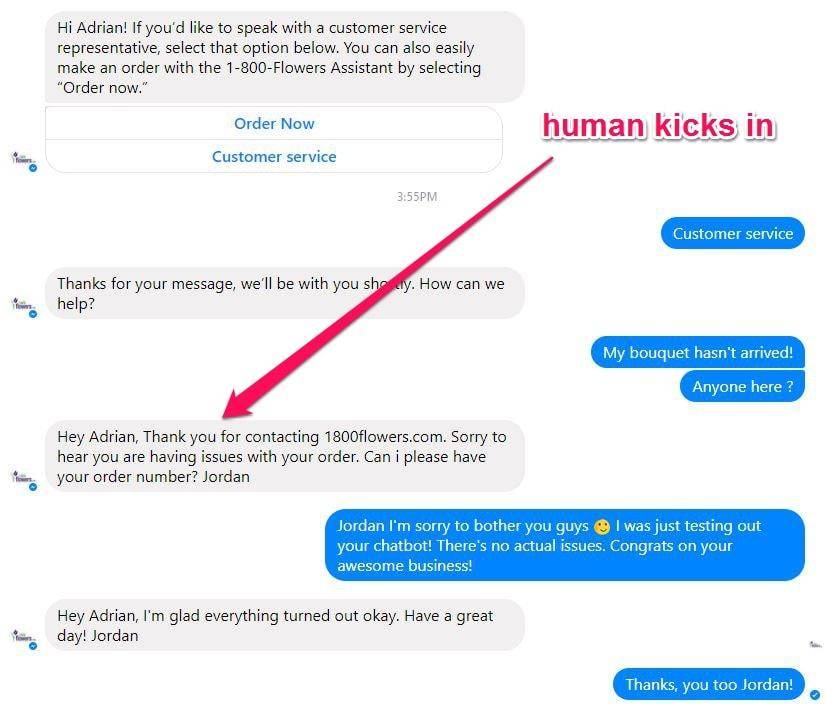
Twitter also has a support bot up and running. It’s a great way to learn about Twitter if you’re just starting out.
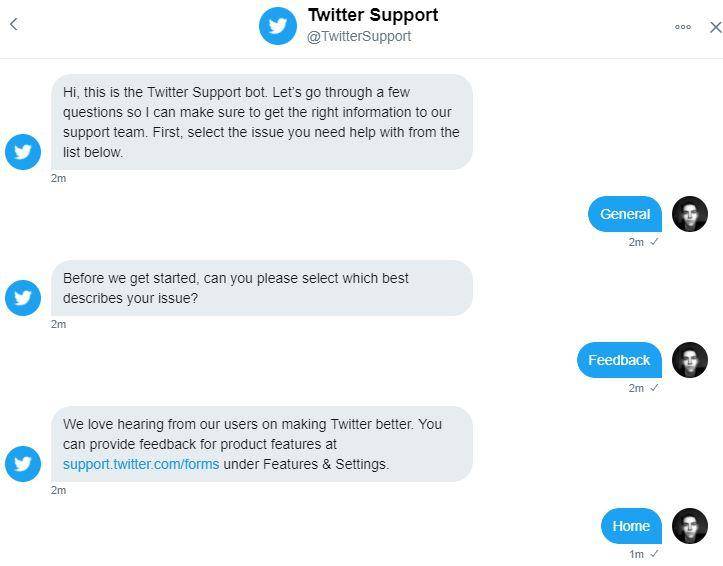
You can only talk to it by tapping the buttons, so you aren’t really chatting with it. Playing with it, I can say it’s more like a FAQ database and knowledge base.

Big brands and businesses are already using this technology to reduce waiting time, and are even taking it to the next level. Enterprise chatbots for support might be expensive, but the investment is minimal compared to a whole support staff.
A friend of mine told me about an experience he had when calling a bank to solve an issue. He said that only by the time he ended the call did he realize he was actually talking to a robot.
There are many other ways you can use chatbots to improve your online marketing campaigns, but the ones listed above are the most popular and feasible. You can find many other ideas out there, from consumer analysis to personalized ads.
3.5 Marketing Automation & Sales
Chatbots can manage marketing messaging, engage website visitors, and promote products without the need for human intervention.
They can also be deployed in marketing campaigns to send generated leads directly to sales teams for follow-up. Some chatbot marketing examples include using chatbots to assist in loyalty programs, deliver real-time news and updates, and increase conversions on landing pages.
Bots with machine learning capabilities improve over time by analyzing interactions and offering more accurate product recommendations.
5. Can ChatBot Marketing Improve SEO ?
Having a chatbot-only website sounds cool, but one of the challenges with chatbots is that the content stored in the database is not indexable by search engines, limiting SEO benefits. Chatbots in marketing provide many advantages, but they don’t directly impact SEO in the same way as indexable content.
This is why marketing agency experts, like Sujan Patel, advise sticking to conventional SEO for important content. Make sure your key pieces of content are also posted on your website in a format that can be crawled by search engines.
| Chatbots & SEO are two very different things. Make your content indexable and crawlable and stick to conventional SEO wisdom. | |
 |
SUJAN PATEL |
| Blogger at sujanpatel.com / @sujanpatel | |
But chatbots directly on your website can bring some SEO advantages. Dwell time and bounce rate are linked to rankings. Improving them can also grow your position in Google.
However, there are still benefits of using chatbots for lead qualification and generated leads that can indirectly support your SEO. For example, chatbots can improve response time, keep customers engaged, and boost social media strategy by increasing customer queries and boosts engagement.
A chatbot that enhances the user experience will likely improve dwell time and reduce bounce rates, both of which are ranking factors for Google.
As Paul O’Brien says, AI customer interactions that encourage users to stay on a site, share it, or return to it can positively impact Google rankings.
| SEO has far less to do with content and words than people think. Google ranks sites based on the experience people have with brands. If a bot can enhance that experience in such a way that people are more enthusiastic about a site – they share it, return to it, talk about it, and spend more time there, it will affect positively how the site appears in Google. | |
 |
Paul O’Brien |
| Blogger at seobrien.com / @seobrien | |
On the other hand, Paul also tells us that if the bot negatively impacts the website, then the rankings can also drop.
Chatbots can also help you get links, likes and shares.
If you decide to build your own chatbot and integrate it into your partner program, chatbots can engage users throughout their journey, providing benefits of chatbot marketing like answering queries instantly, guiding them to relevant content, and improving overall customer engagement. This is especially valuable for lead qualification, where chatbots provided immediate responses and help convert visitors into leads.
To stand out in chatbot marketing, it’s crucial to be creative and original. Chatbots in marketing can enhance customer queries, offer real-time support, and boost generated leads through personalized interactions.
Incorporating chatbots into your social media strategy and website can provide the benefits of chatbots, such as improving the user experience, speeding up response times, and boosting engagement with potential customers.
In the constantly evolving marketing landscape, especially when targeting millennials, chatbot marketing is a powerful tool. By integrating AI customer interactions and chatbots into your overall marketing efforts, you can not only increase engagement but also encourage customers to engage more deeply with your brand.
Keep in mind, though, that it’s essential to balance this innovation with traditional SEO techniques to ensure your content remains visible and indexed in search engines.
If you liked this article, have any questions or feel I missed some points, please feel free to drop off a comment in the section below. Let’s get the conversation started!

 Site Explorer
Site Explorer Keyword tool
Keyword tool Google Algorithm Changes
Google Algorithm Changes

Wow, what a comprehensive and interesting article! Great job! I started offering chat bots to my clients some time ago, so far not many are interested.
PJ, thanks for the feedback. Yes, people are not really aware how powerful chatbots can be. As I said in the article, the trend is falling now (Trough of Disillusionment). But the clients that start implementing chatbots now will have an advantage in the future.
Comprehensive article. Really enjoyed it.
Glad you did, Tolu! Thanks so much for the feedback 🙂
I believe chatbots still have ways to go and are still in Generation 1, the exciting future of transactional and conversations commerce with deeper NLP capabilities will be the tipping point.
Yeah..Chatbots are giving better results than ever before and engaging more audiences to the website.Great article.Covered almost all related topics.
Stunning, what a thorough and fascinating article! I began offering visit bots to my customers some time prior, so far relatively few are intrigued.
Thank You Adrian, for sharing the advice of some top experts like Sujan Patel on chatbot marketing. This post helped a lot in defining the importance and need of a chatbot on a website. Keep up the good work
Chatbots are the future of engagement between a fan and a brand or celebrity. This technology is still in an early stage, its capabilities continue increasing and provides several benefits that can be used in your business. Online chatbots save time and efforts by automating customer support. Thanks for sharing such a piece of useful information with us.
Chatbot marketing is the next-gen marketing technique in the field of digital marketing.
Was a great read.
The pandemic has been tough on companies. Companies need to conduct swot analysis in order to find opportunities to tap on and get an edge over their competitors.
With the current developments in AI chatbots companies can switch to them in order to provide an seamless experience over all channels and also collect the important data to know the touchpoints of their customers.
Ai chatbots play a crucial role not only in FAQ’s but also in engagement and driving sales into the business.